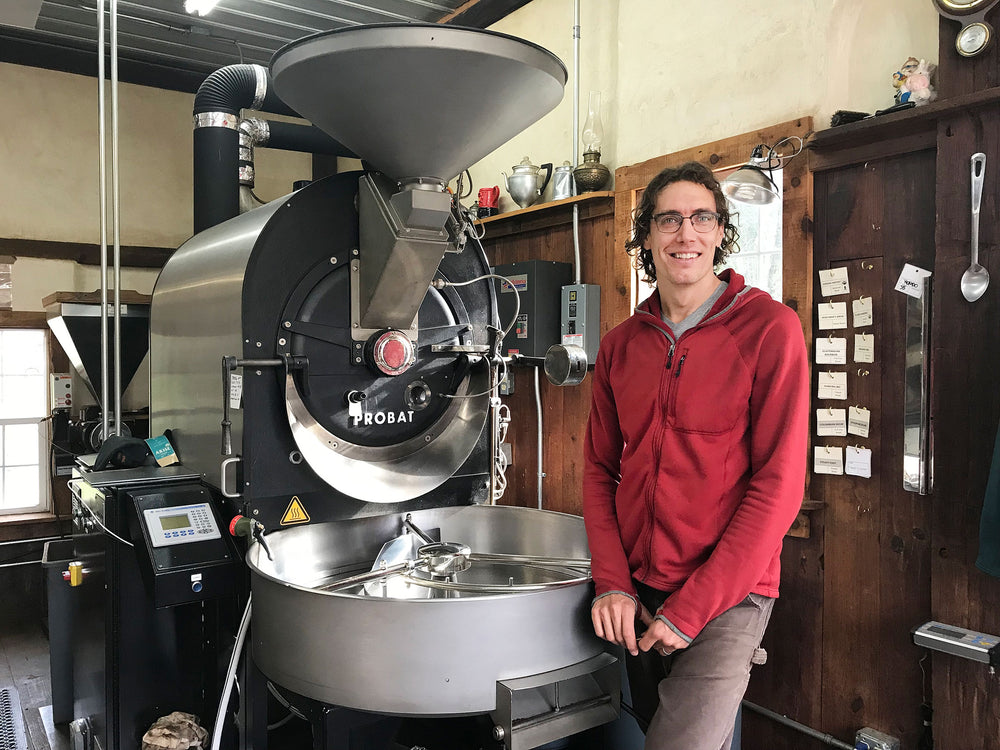
Today we carved out some time to relax canal-side with Trevor and pick his brain about coffee roasting, to learn a little more about his personal process and experience with the trade.
What are common misconceptions that people have about coffee roasting?
Probably concerning coffee flavor - when people come visit us in the Roastery, I think that they assume that all coffee beans taste the same and that the flavor comes from how light or dark you roast it. When in reality, each bean has its own unique flavor and it's the job of the Roaster to highlight those flavors - drawing them out through the roasting process.
When you're sampling a variety of new coffee beans to see which bean you'd like to bring into the Homestead lineup, what is your process? How do you know how to roast all of those different beans when you've never even tasted them before?
Say we have about ten different farms/coffees to try, we'll roast all of those the same. Our sample roast is consistent from day to day, week to week, season to season - we'll roast the coffee to the same roast level each time to minimize inconsistencies. We'll roast them to a specific temperature and color, and then try them all.
Our sample roast is on the lighter side of what we would consider a production roast - the reason being is that with the lighter roasts you can start to pick out nuances and see how much more acidity is in one coffee as compared to another. There is a direct correlation between acidity and potential flavor. You might have one coffee that's very acidic and know that those acids, given a darker roast level, will turn into, say, maybe caramelized sugars.So it helps to be able to recognize the potential for more flavor to exist.
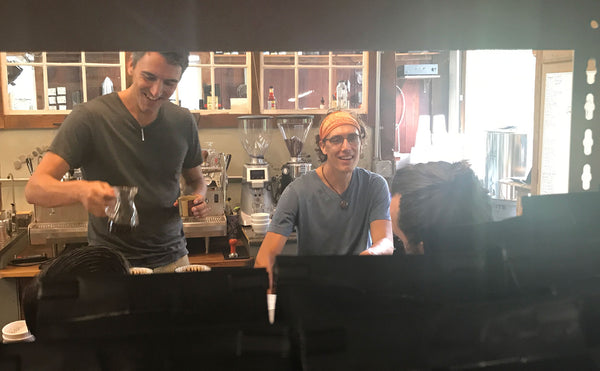
So when you do then select the new bean and acquire it, what is your process of figuring out the best production roast for it?
So let's say that we've sampled ten different beans and we've picked one that we've decided to bring into our offerings. The next phase would be to do a larger roast with it where we'll pull maybe ten samples, in intervals of 3-5 degrees, along the way as the coffee roasts - from the first crack to the finish temperature. Then we'll sample all of those.
What is the finish temperature? Does that vary from bean to bean?
The finish temp is the highest temperature the beans reach in the roaster before we drop them out into the cooling tray. And it does vary. Usually we'll have some preconceived ideas as to where the flavor might lie from the sampling process, but typically we'll purposefully roast it darker than we're anticipating, even if it's only just to be able to get some samples out of it that are darker.
Say you wanted to bring in a new light roast, for example, are there certain types of beans or countries you would look to to find the right bean or does it not work like that?
Yes it does, at least we do work like that. I'm sure there will always be examples where it's different, but if we break it down regionally, we're usually looking at Central America, South America, East Africa, and Indonesia. In large swaths, each one of those has its own unique characteristics. For example, we usually don't look to Indonesia for lighter roasts; they typically have flavors that shine better at darker roasts. If we were looking for a light roast, it would probably be something more of an East African bean - they're typically more acidic and offer some unique flavors at a light roast where if you were to roast it darker, those flavors might just get lost and washed out.
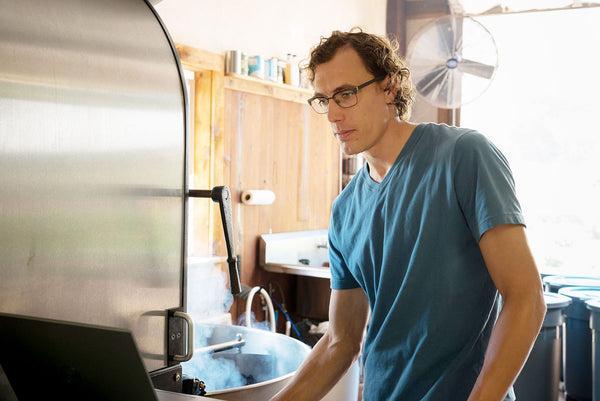
People describe coffee roasting as an art or a craft. Can you share what that means to you?
Sure. When I think of craft, I think of something handmade. Coffee roasting is very sensory - we're using sight, sound, smell, taste - and manipulating the coffee by hand, making adjustments guided by those senses. And the art of coffee roasting, for me, goes hand in hand with the craft. The craft becomes art when it travels outside of our roasting barn and hits the shelves and people start to enjoy and experience our coffee. To me that's the art of it. It's like an expression - being able to take a unique bean, hone it to what we think is the best way to highlight this coffee, and then it becomes art when we deliver it to the people. That's what that means to me.
What excites/inspires you about the coffee industry?
One of the things that really inspires me is the craft of it - it is a craft at every step of the way. Lots of hands are involved in the process of creating a good cup of coffee from start to finish. We're in the unique position that we really do work with other people and there's a human touch the whole way.
What is the most challenging aspect of coffee roasting?
There are a few things that are really challenging. If I look at the actual roasting it would be consistency. Sometimes it's pretty difficult to maintain consistency between batches. Usually right about the time you get a coffee figured out - how it's gonna roast and react to heat - and you get it exactly how you want it time after time, that season's over and we're on to a new season of crop and it's like - OK, we need to figure this out again. But that's part of the job - part of the handcrafted aspect of the job.

How does the changing of the seasons effect what you do?
On a few different levels. If we talk about annual, seasonal crops from one season to the next - you may be buying the same Colombian coffee from one year to another and you never know how that season's going to effect the bean. What really worked as a great medium roast this year, you can get the same coffee next year and it might not be exactly where we want to hit it.
On a broader scale, here in the Northeast as we move from summer to fall to winter and spring, it has an effect on how we approach the roasting process. We're working in a non-temperature controlled environment. There's a big difference if you drop in coffee that's been sitting in a tote at 65 degrees vs. when it's mid-summer and it's 90 degrees - that 25 degrees makes a big difference. It's going to change how you charge the roaster - if we're going in 25 degrees colder it means I better store a lot more heat in the roaster before I put that coffee into it.
That's also true for spring when it's going to be really humid and wet, and the moisture content of the bean is up a little higher - same thing. We've really got to keep that in the back of our heads.
How do you create balance for yourself in and outside of work?
Balance inside of work has, in some ways, become easier and easier with time as we've gotten bigger and production has increased - I know every day what I'm walking into. Our jobs became less varied. Outside of work - how do any of us do it? I have a good community outside of work, good friends, good support network. I like to have fun and let loose a little bit. Create more art - that's where I'm at right now - I've been drawing a lot. I want to keep creating more. I create at work and go home and create some more. I feel very lucky to be able to do that.
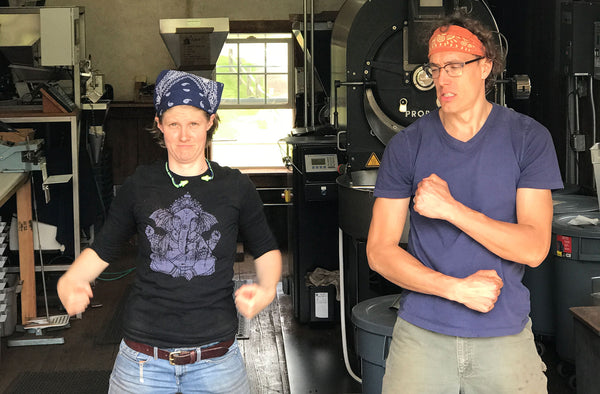
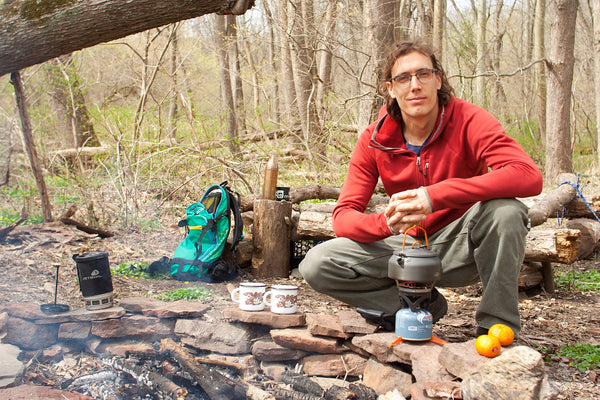


Leave a comment
Also in News
Why We Work Exclusively With Small Farms
April 24, 2024
Continue reading
Exploring a Transforming Colombia - Comuna 13 in Medellín
April 07, 2023 2 Comments
Continue reading
2020 Thoughts and Gratitude
September 18, 2020 4 Comments
Continue reading